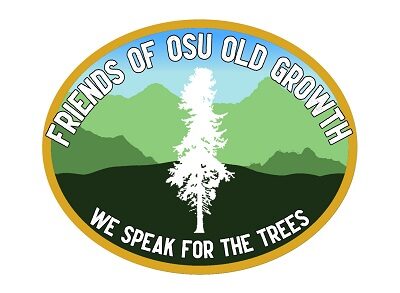Background on OSU’s current planning process: In June 2022, Oregon State University began a long-overdue update of their management plan for the (~11,250-acre) McDonald-Dunn Research Forests located near Corvallis. The current management plan for these public forests1 was adopted in 2005. It was subsequently abandoned in 2009, then reinstated after the controversial decision of College leaders to cut 16 acres of old-growth forest in 20192.
One might reasonably ask why our nation’s self-proclaimed “leader in forestry education” neglected to follow their own forest management plan for an entire decade, and why it took 17 years for them to begin updating it. The short answer is that ignoring the plan made logging these public forests a heck of a lot easier (and far more lucrative). Spotted owl habitat the plan had promised to protect (~166 acres of it) was subsequently cut3. Restrictions on the size of clearcuts were conveniently ignored. Old growth OSU had promised to protect was liquidated. College leaders could simply claim they didn’t violate the plan because the plan no longer applied. If you don’t like the rules, just throw them out!
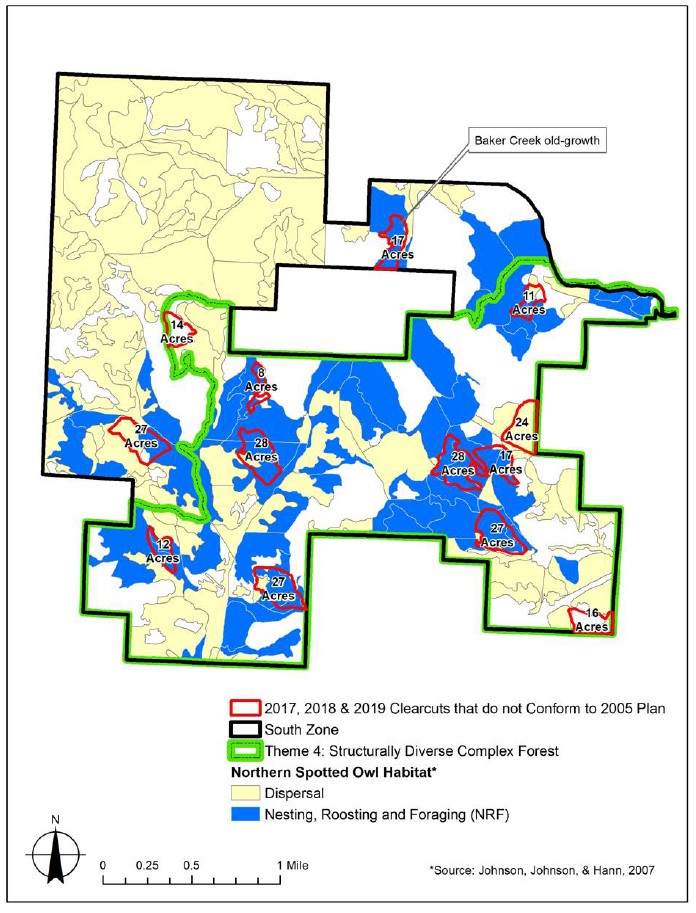
This map of the southern portion of the McDonald Forest shows clearcuts in northern spotted owl habitat (blue areas) that violated OSU’s 2005 Forest Plan (map above and images below were taken from “Damage to Ecological Resources on the OSU McDonald-Dunn Forest“).
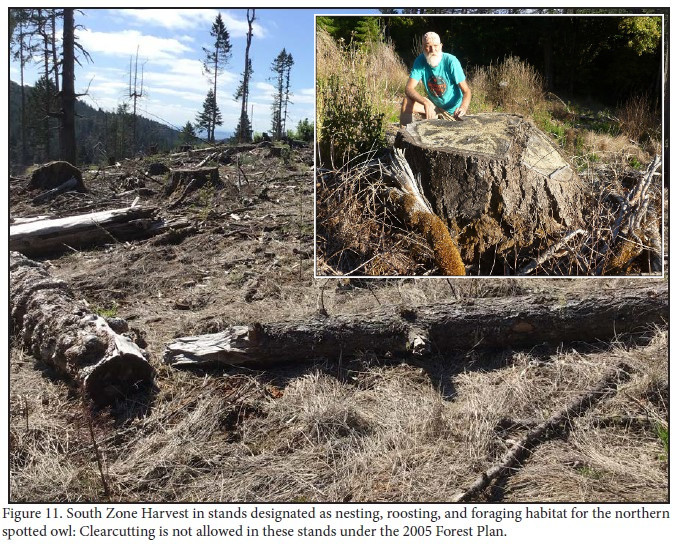
Dean’s unilateral approach violates collaborative planning commitment: in the wake of the 2019 old growth cutting scandal, the previous dean of the College of Forestry, Anthony Davis, promised an outraged community that OSU would follow a collaborative approach when revising the management plan for the McDonald-Dunn. Unfortunately, the current dean, Thomas DeLuca, has violated that commitment in a number of important ways. These include the development of the “Vision, Mission, and Goals” governing the OSU Research Forests without any public notice or involvement, implementing a forest planning process dictated and controlled by College leaders, and now ignoring well-established standards for public review (more on that below).
Traditional vs. Collaborative Planning Models: the process of forest planning has been studied for decades and was the subject of a previous blog piece: “Traditional vs. Collaborative” – how OSU’s leaders are violating their collaborative commitment to forest planning. I have shared this information with OSU and College leaders on several occasions over the past couple of years, expressing concerns about the university’s approach. I have been asking them specific questions about OSU’s forest planning process for roughly two years, but have yet to receive answers (they won’t even acknowledge my questions, despite repeated requests via email and at meetings of the OSU Trustees).
Secretive process excludes public and injects bias: OSU’s current forest planning process was biased from the outset when the dean chose his so-called “Stakeholder Advisory Committee” (SAC) behind closed doors. The public was never given the opportunity to apply to serve on the committee (despite my requests). We only learned what was going on when the appointment of SAC members was announced in June of 2022. Predictably, nearly all of the committee members have pre-existing relationships with the College of Forestry. This has imparted a substantial implicit bias to the forest planning process.
Lack of academic diversity taints internal planning committee: the dean’s “Faculty Planning Committee” (FPC), the internal group developing the new plan for the McDonald-Dunn, is heavily skewed toward the College of Forestry. Only 2 of 11 members hail from outside the forestry ranks, and there’s no public representative (as on past planning committees). OSU has eleven separate colleges, but only two are represented on the McDonald-Dunn FPC. One wonders why the OSU Trustees gave their tacit approval to this committee which is so lacking in diversity.
To learn more about the systemic biases in OSU’s approach to forest planning, read my blog piece, “OSU’s Forest Planning – More Broken Promises“.
—————————————————————————————————————————
FAST FORWARD TO MAY 2024: After two years of committee meetings (where public comments were prohibited) and a considerable effort on the part of OSU’s Research Forest staff (whose salaries come from logging the forest), we’ve finally gotten a glimpse of how OSU plans to manage these public forests. What we are now seeing is deeply disturbing!
Before I dive into the details, it is important to note that SAC members (who ostensibly represent our community) were largely kept in the dark as College insiders concocted their management framework for these public forests. The SAC last met in October of 2023 (more than seven months ago). What started as a deliberative process back in 2022 reportedly devolved into the associate dean (Holly Ober) telling committee members what had been decided by the College’s internal planning team. At the same time, important questions raised by SAC members were often ignored.
Back-to-back meetings prevent meaningful engagement: these internal tensions and the flaws of OSU’s planning process are now coming to a head after the recent announcement from College leaders that the stakeholder committee will meet on June 3rd, 2024, followed by a “community input session” on June 5th. SAC members have raised concerns about the short timing and the lack of information for their upcoming meeting. It is hard to imagine how they can adequately inform their constituents in the two days before the public meeting. After all, the dean claims he picked these folks as community representatives – which implies some back-and-forth communication with the groups they represent.
Our first glimpse at OSU’s new management (logging) plan: In response to concerns from SAC members, College leaders only recently shared a 4-page document describing their new management framework for the McDonald-Dunn. Titled, “Spring 2024 McDonald-Dunn Research Forest Plan Development Request for Your Input on Alternative Land Allocation Scenarios”, the document is predictably heavy on technical jargon and chock-full of loaded language and assumptions.
These forests shall be LOGGED INTENSIVELY!: Reading OSU’s document, a few things immediately jump out. First, none of the five scenarios are a “NO LOGGING option”. OSU makes it very clear that intensive, rotational (clearcut) forestry will occur across a large swath of the McDonald-Dunn. Three of the five scenarios allocate between 45% and 72% of the forest to active management (short or long-rotation clearcutting, and mixed stands that will be thinned in various ways). There’s no mention of “ecological forestry”, which seems like a glaring omission considering OSU’s experts wrote the book on this important field.4 This is a predictable outcome of the antiquated “working forest” model that OSU promoted for the Elliott State Research Forest. It prioritizes timber production over everything else (such as ecological services, wildlife habitat, forest carbon, recreation, and wildfire resilience). This model was widely rejected in the Elliott process, even by OSU’s own experts.5

All five scenarios analyzed in OSU’s first round of modeling for the McDonald-Dunn relegate substantial areas of the forest to industrial forestry. The “least worst” scenario (E) still subjects 45% of the forest to intensive logging.
Equally troubling is the lack of reserves (only 19% in the “least worst” scenario), and the substantial lessening of protection for older forests. Old growth that has been protected for decades will now be categorized as, “managed reserves”. This will allow OSU’s foresters to treat the reserves:
“when needed to promote and maintain historical older-forest structural and compositional diversity, visual aesthetics, and provide for public safety…Areas added to the existing reserve base may need more active operations [logging] to promote the development of historical conditions.“ (quoting from OSU’s draft guidelines for their new ‘management strategy’)
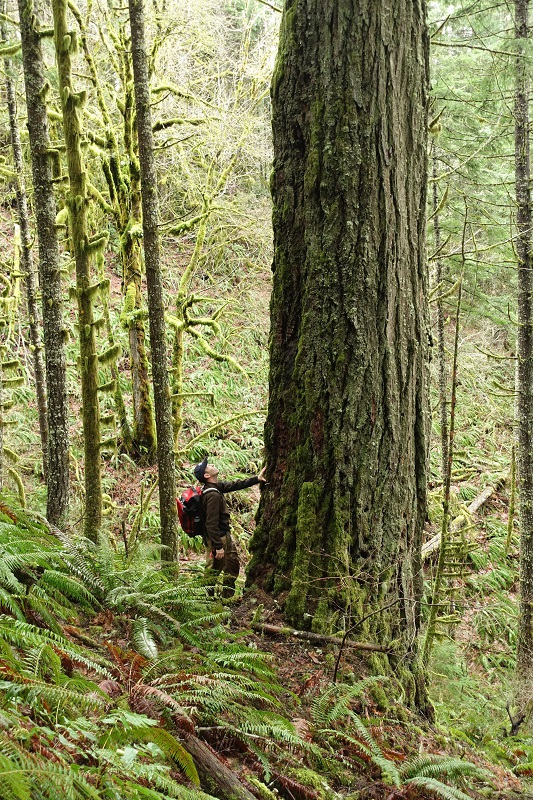
Under the new plan for the McDonald-Dunn, OSU intends to change old-growth reserves to “managed reserves” to allow their foresters to treat (log) older forests for a variety of subjective reasons (including “visual aesthetics” and “public safety”). Reserves must be off limits to ALL logging!
In 2019, College of Forestry leaders tried to justify their cutting of old growth with the “public safety” excuse. They falsely claimed that the trees posed a risk to recreational users of the forest. They also claimed that OSHA requirements dictated they cut the trees (claiming the trees posed a risk to the loggers doing the cutting). We should fully expect future forest managers to use this expansive loosening of protection to justify logging in older forest stands. “Visual aesthetics” and “public safety” give enormous latitude for interpretation – and OSU’s loggers seem to err on the side of cutting.
Language and framework designed to support OSU’s authority: the language of OSU’s planning document is loaded with bias and flawed assumptions. They state, “We’re using mathematical programming as a tool to make data-driven decisions.” Who could be against “data-driven decisions”?! The message seems to be, “You should trust us because we use data, not emotions, to reach our conclusions!“. But as anyone with even a rudimentary understanding of science knows, “data” can be used to justify even the most destructive and unfounded conclusions (just look at the tobacco industry’s long history of false research).
Data often comes with an agenda: Just as “research” can be used as an excuse for logging, every set of data comes with qualifications. The quality and relevance of data is completely dependent on human choices: what was measured and what was ignored? When and where was the data collected? How frequently was it collected? What are the limits of the measurement tool and sampling used? What biases do the researchers bring to their work? What are they choosing to study and who funded it?
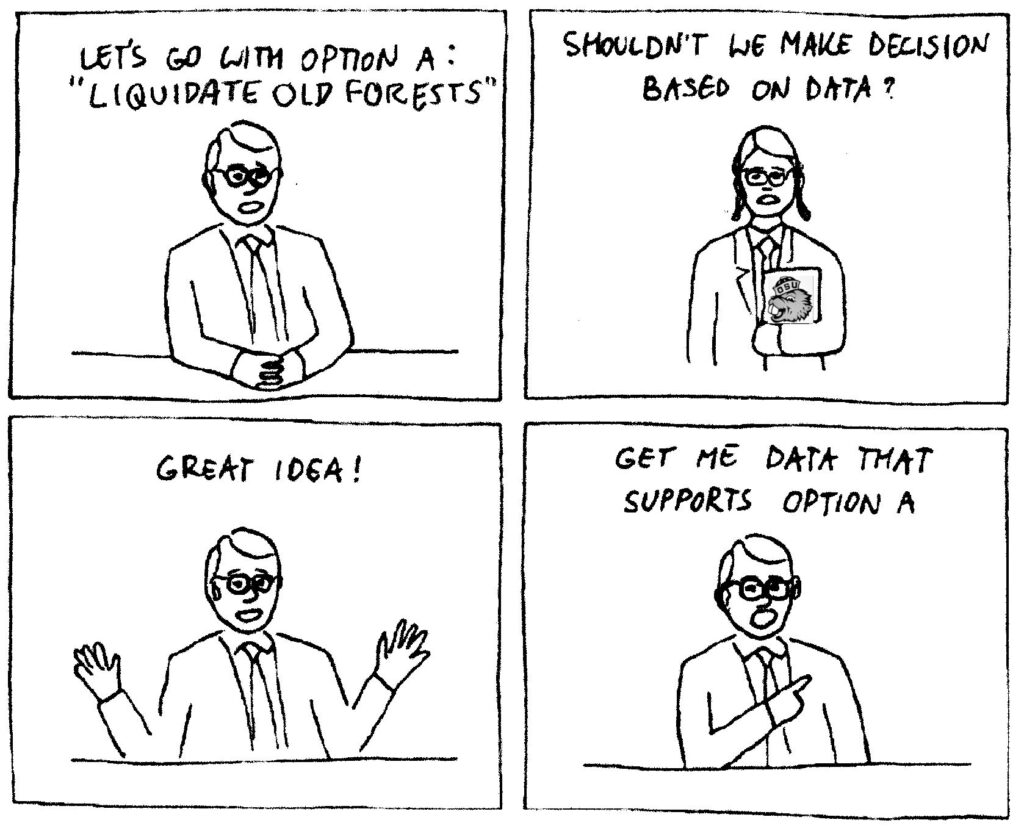
Simulations tainted by those doing the modeling: the same concerns apply to the simulations and metrics used to develop OSU’s forest planning scenarios. College leaders hired Mason, Bruce & Girard, (M,B&G), a large, traditional forestry consultant (with deep OSU roots) to do their forest modeling. Rumor has it that OSU’s Research Forest Director (the guy responsible for deciding to cut the old growth in 2019) served as the primary liaison between the planning team and M,B&G. With a long history of pro-timber bias6 and a salary dependent upon continued logging of the forests, the director of the research forests has substantial conflicts of interest. He should have never been allowed to play a leading role in the planning process.
A complete absence of a public review period violates basic rules of engagement: it is also important to note OSU has not yet shared their proposed management scenarios with the general public. The 13 Stakeholder Advisory Committee members are the only ones who’ve received it. Presumably, College leaders intend to drop this information on citizens at their upcoming “community input session”.
Overwhelming the public with information to constrain choices and control the narrative: how OSU can expect the public to process all of this information and make informed choices in the span of one short meeting boggles the mind. It is as if College leaders are completely clueless about conventional public comment periods (which typically allow 30-60 days for review, and 180 days or more for complex rulemaking).
Keep in mind College leaders just spent five years co-managing the Elliott State Research Forest initiative. During the Elliott process, OSU and their Department of State Lands collaborators were routinely criticized for providing inadequate comment periods. It seems the dean and his team failed to learn some important lessons. Citizens deeply resent public officials who routinely violate their basic rights while claiming to value public input.
Based on the limited information OSU recently shared with the SAC, here are some of our main concerns:
Deficiencies of OSU’s “Land Allocation Scenarios” for the McDonald-Dunn:
-
-
-
-
-
-
-
- OSU has not allowed for a “No Active Management” (no logging) option, even though a substantial portion of the public likely favors this scenario.
-
-
-
-
-
-
-
-
-
-
-
-
-
- Management scenarios have a heavy reliance on hidden assumptions, data, and simulations which are only vaguely predictive and objective.
-
-
-
-
-
-
-
-
-
-
-
-
-
- Public review has been circumvented by presenting “5 new forest management strategies” as the indisputable approach to forest management.
-
-
-
-
-
-
-
-
-
-
-
-
-
- There is an underlying assumption that these “research forests” will be heavily managed, as shown by a sharp focus on even-aged rotations (clearcuts).
-
-
-
-
-
-
-
-
-
-
-
-
-
- No commitment to “ecological forestry” is apparent in any of the scenarios or explanatory material.
-
-
-
-
-
-
-
-
-
-
-
-
-
- Previously protected stands (e.g. old growth) will now be defined as “managed reserves”, opening the door to “treatments” (logging under the guise of stewardship). This is a substantial reduction compared to current protections for old growth reserves.
-
-
-
-
-
-
-
-
-
-
-
-
-
- The least damaging scenario (E) still allocates 45% of the forests to timber production, depriving the public of any meaningful choice to minimize industrial forestry impacts in these public forests.
-
-
-
-
-
-
-
-
-
-
-
-
-
- Three of the five scenarios dedicate over HALF of the McDonald-Dunn to even-age (clearcut), monoculture forestry. This is completely out of touch with societal values and expectations, and diminishes research opportunities not tied to logging.
-
-
-
-
-
-
-
-
-
-
-
-
-
- Even the most ecological scenario (E) has only 19% of the forests set aside in “managed reserves”.
-
-
-
-
-
-
-
-
-
-
-
-
-
- Metrics for biodiversity are rudimentary and ignore important taxa (e.g. all below-ground organisms) leading OSU to falsely conclude intensive forestry provides the best biodiversity.
-
-
-
-
-
-
-
-
-
-
-
-
-
- Recreation metrics are opaque, lack relevance and do not reflect overwhelmingly negative views about industrial forestry and clearcuts.
-
-
-
-
-
-
-
-
-
-
-
-
-
- Carbon storage metrics appear to ignore carbon below ground (a significant source of sequestration).
-
-
-
-
-
-
-
-
-
-
-
-
-
- The model’s “resilience – density” metric promotes even-aged stands and devalues older, complex forests (which are highly resilient), showing a clear bias toward timber production.
-
-
-
-
-
-
-
-
-
-
-
-
-
- The “wildfire resistance” metric falsely shows older, diverse forests having lower resistance to wildfire (old growth forests are substantially more resilient and resistant to wildfire than industrial forest lands, as OSU research has repeatedly shown).
-
-
-
-
-
-
-
-
-
-
-
-
-
- There is no data provided on maximum harvest sizes to be allowed.
-
-
-
-
-
-
-
-
-
-
-
-
-
- There is no data provided on the maximum harvest age to be allowed.
-
-
-
-
-
-
-
-
-
-
-
-
-
- There is no information showing the distribution of age classes in the forests (information which is critical to forest planning).
-
-
-
-
-
-
-
-
-
-
-
-
-
- There are no maps to indicate the geographic distribution of the proposed treatment scenarios. This is absolutely vital information to consider in order to make informed decisions!
-
-
-
-
-
-

Glaring deficiencies and false conclusions abound in OSU’s latest modeling metrics for the McDonald-Dunn forest planning. Their “data-driven decisions” and simulations falsely indicate that the scenario with the largest reserves of old forest would have less wildfire resistance than ones with intensive industrial forestry. Their biodiversity metrics fail to account for the high diversity of micro-organisms in the soil of older forests and give meaningless results based on the limited, arbitrary choice of six taxa. Similarly, the “recreation acceptability” metric shows little difference between the scenarios with the most intensively managed forests and the one with the largest reserves. This is completely nonsensical and contrary to public opinion!
- Oregon Revised Statute (ORS) 352.025 (2) (c) states,”Legal title to all real property, whether acquired before or after the creation of a governing board, through state funding, revenue bonds or philanthropy, shall be taken and held in the name of the State of Oregon, acting by and through the governing board.” In short, the property titles to the OSU Research Forests are held by the State of Oregon which equates to public ownership of these lands. The OSU Trustees are the stewards of these public forests.
In a February 12, 2024 letter to the executive director of the Oregon Chapter of the Sierra Club, Dean Thomas DeLuca wrote, “It is important to note that the OSU Research & Demonstration Forests are not “public forests,” regardless of what some local landowners inaccurately suggest.” Like previous leaders of the College, dean DeLuca provides no factual basis for his assertion.
Generations of College leaders have vigorously asserted their authoritative control over the McDonald-Dunn (and OSU’s other “research forests”). They have made claims that the forests “belong to” the College of Forestry and were intended to be used for timber production (both of which are untrue). They have made thinly veiled threats about taking away recreational access. In 2023, College leaders sold a substantial portion of older forest in the Dunn to one of their largest donors for a tiny fraction of its value. The Spaulding Research Forest was also given away in a secret land swap. These actions reveal a supreme arrogance on the part of College leaders and diminish public trust in OSU. ↩︎ - Lead story in The Oregonian, July 26th, 2019: https://www.oregonlive.com/environment/2019/07/majestic-douglas-fir-stood-for-420-years-then-oregon-state-university-foresters-cut-it-down.html ↩︎
- For a comprehensive report on violations of OSU’s 2005 Forest Plan see: https://friendsofosuoldgrowth.org/wp-content/uploads/2019/09/Damage-to-Ecological-Resources-on-the-OSU-McDonald-Dunn-Forest.pdf ↩︎
- Published in 2018, Ecological Forest Management is a comprehensive textbook written by Jerry K. Franklin, K. Norman Johnson, and Debora L. Johnson. All three authors have had extensive connections to OSU. For an overview of the book, see: https://www.waveland.com/browse.php?t=730 ↩︎
- Dr’s. Jerry Franklin and K. Norman Johnson wrote a scathing critique of OSU’s approach to the Elliott State Research Forest which they submitted to the Oregon Land Board and OSU in November, 2020. You can read their letter here: https://friendsofosuoldgrowth.org/wp-content/uploads/2024/06/Franklin-Johnson-Comments-for-the-ESRF-Draft-Plan-submitted-to-Oregon-Land-Board-28-Nov-2020.pdf ↩︎
- In January, 2006, a group of OSU professors (including OSU’s recently retired Research Forest Director, Stephen Fitzgerald) tried to delay publication of a peer-reviewed study conducted by an OSU graduate student in the journal Science. Their effort was widely viewed as an attempt at censorship because the research disagreed with their long-held beliefs that post-fire salvage logging was appropriate and did not have adverse impacts on forest regeneration. Internal emails revealed the College of Forestry dean (Hal Salwasser) had coached a timber industry spokesman about how he could undermine the OSU study. The dean also referred to environmentalists as “goons”. For a brief overview see: https://en.wikipedia.org/wiki/Biscuit_Fire_publication_controversy ↩︎
